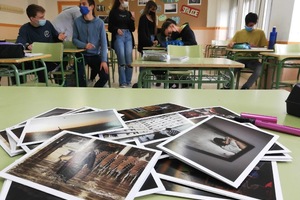MISSION: TO ACHIEVE EMPATHY AND FRATERNITY POST-PANDEMIC. GOAL: ACHIEVED.

In the 2020/2021 academic year, as difficult as it started, under the effects of the fourth and fifth waves of the global pandemic, we, the CIVES Foundation have managed to develop the BEST project in Spain with considerable success. We managed to get 29 centers involved from eleven provinces in Jaén, Gran Canaria, Murcia, Cádiz, Palencia, Valencia, Valladolid, Zamora, Burgos, Toledo and Madrid. All of them incorporated our dynamics into their school calendar for the season. In addition, we could work with different types of education centers in several levels: 19 high schools, 7 primary schools, a playroom, an art school and a university.
At CIVES Foundation we are very satisfied that all of them responded and participated with enthusiasm and dedication in this activity of experimentation with fraternity and empathy in young people, since these values are more than necessary at present time.
More than one hundred participating teachers (101 and two educators) shared some thoughts on the results and impact on the nearly two thousand (2,011) students between 7 and 18 years old, with whom they have worked. These are some:
"We have developed their critical thinking, and the students have understood that what we do at school is not disconnected from what happens on the street, they feel part of society, it allows them to reflect on current problems."
"We have had the opportunity to visualize many problems thanks to the BEST experience that normally the kids feel not connected to"
For the center it is a positive experience, since it implies an opening of the center to the community: "the students carry out an activity in which other agents from their environment and they learn to participate."
The teaching staff of the 29 participating centers received several training sessions in image and writing before implementing the experience with the students:
Two image analysis sessions were held in which they worked on the analysis of the photographs, prior to them developing it in the classrooms, with the aim of providing a reflection based on their analysis, facilitating that the teachers can carry out with their students the proposed workshops with the most worked images on two levels: a morphological one, through the visual elements of the image, and a semantic one based on the meanings, stories and transmitted emotions.. You can have a look at one of the sessions here.
Likewise, a writing workshop was held to give teachers ideas to write from an image. Focusing on the meanings that emerged from the visual analysis workshop, and from those that have to do with the BEST program proposal for the formation of values (equality, respect for diversity, empathy, solidarity). Also you can go deep into the session here.
In a special way, in the Canary Islands, centers participating wanted to go further and were encouraged to adopt the activity proposed by the BEST project in this second edition: the centers that wished to deepen the activity, were proposed to develop actions of community solidarity, deepening the role that corresponds to us as citizens.
This was just the case in Las Palmas de Gran Canaria. The Arucas and Doramas high schools have deepened after sending postcards and met with centers for minors they had contacted. The first of them, through a virtual meeting between their students and migrant minors in a reception center, while the second carried out a face-to-face meeting, a visit by staff from the center for the elderly and migrants who had received the postcards. All together, workers and students, could talk about the impact of the postcards on the recipients.
In a second round of thoughts with the teaching staff, they identified as a direct benefit of the BEST experience the increase in the empathic capacity of their students:
"BEST has helped us to make explicit what the students think about social issues that are in the photographs, and that allows us to better work on different aspects of discrimination."
"Both the students who send them, and the population that receives them, relate important issues that sometimes we do not think about. It increases empathy by making children aware of the things that happen in life."
"The students are involved with the topics they deal with, because they are the protagonists of the activity."
"The images, once analyzed, show the problems that society faces and empathize with others."
“It is a complement to the work of education in values that is developed on a regular basis. It allows us to continue instilling values in an increasingly individualistic society. "